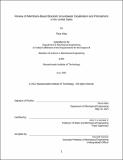Review of Membrane-Based Brackish Groundwater Desalination and Pretreatment in the United States
Author(s)
Klise, Flora
DownloadThesis PDF (1.851Mb)
Advisor
Lienhard V, John H.
Terms of use
Metadata
Show full item recordAbstract
Membrane-based brackish groundwater desalination increases freshwater supply, which is especially significant in arid, land-locked regions. Brackish groundwater is a widely available but underutilized alternative water source in the United States, where the risk of water scarcity is increasing in many areas. A primary limitation of brackish groundwater desalination is particulate accumulation called scaling on the membranes. By pretreating feedwater before desalination by filtering or adding chemicals, a plant can increase its efficiency and decrease total costs by increasing its recovery ratio and decreasing membrane maintenance costs. If left untreated, these scalants accumulate on the membranes and require costly removal treatment techniques. Pretreatment requirements vary with feedwater composition, geography, and technology. The associated capital, operating and maintenance costs of membrane-based brackish groundwater desalination plants with pretreatment in the United States are influenced by factors such as plant capacity, feedwater TDS and pretreatment requirements. Environmental costs include brine disposal and carbon-emitting energy usage.
Date issued
2021-06Department
Massachusetts Institute of Technology. Department of Mechanical EngineeringPublisher
Massachusetts Institute of Technology